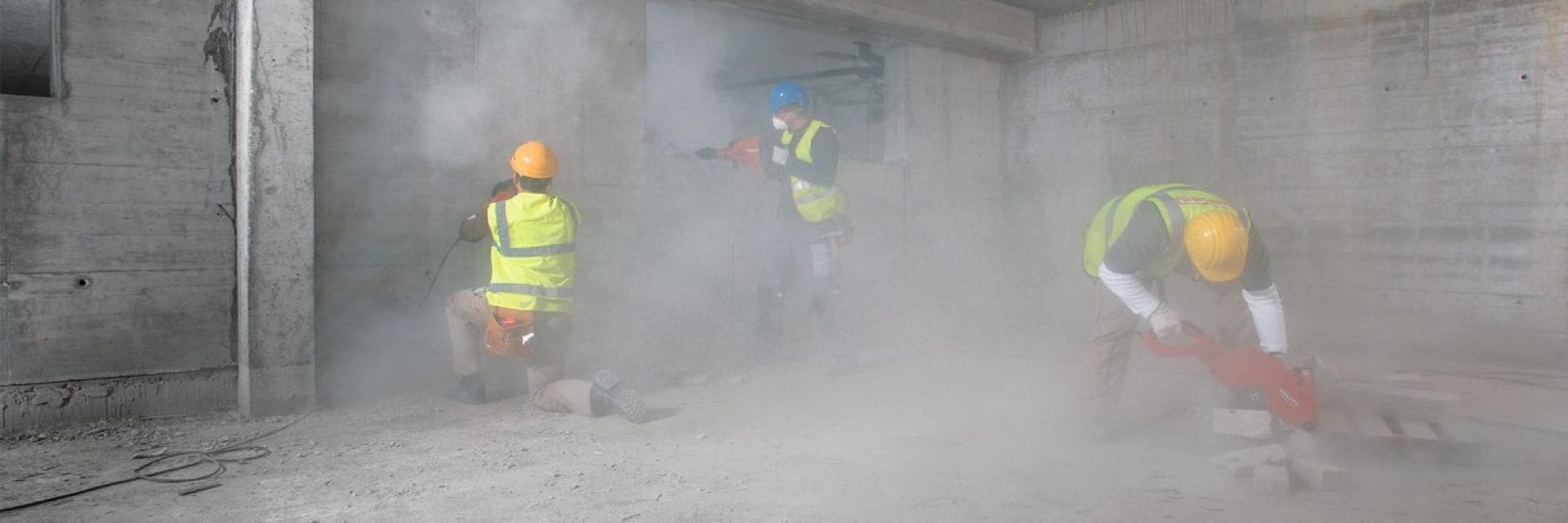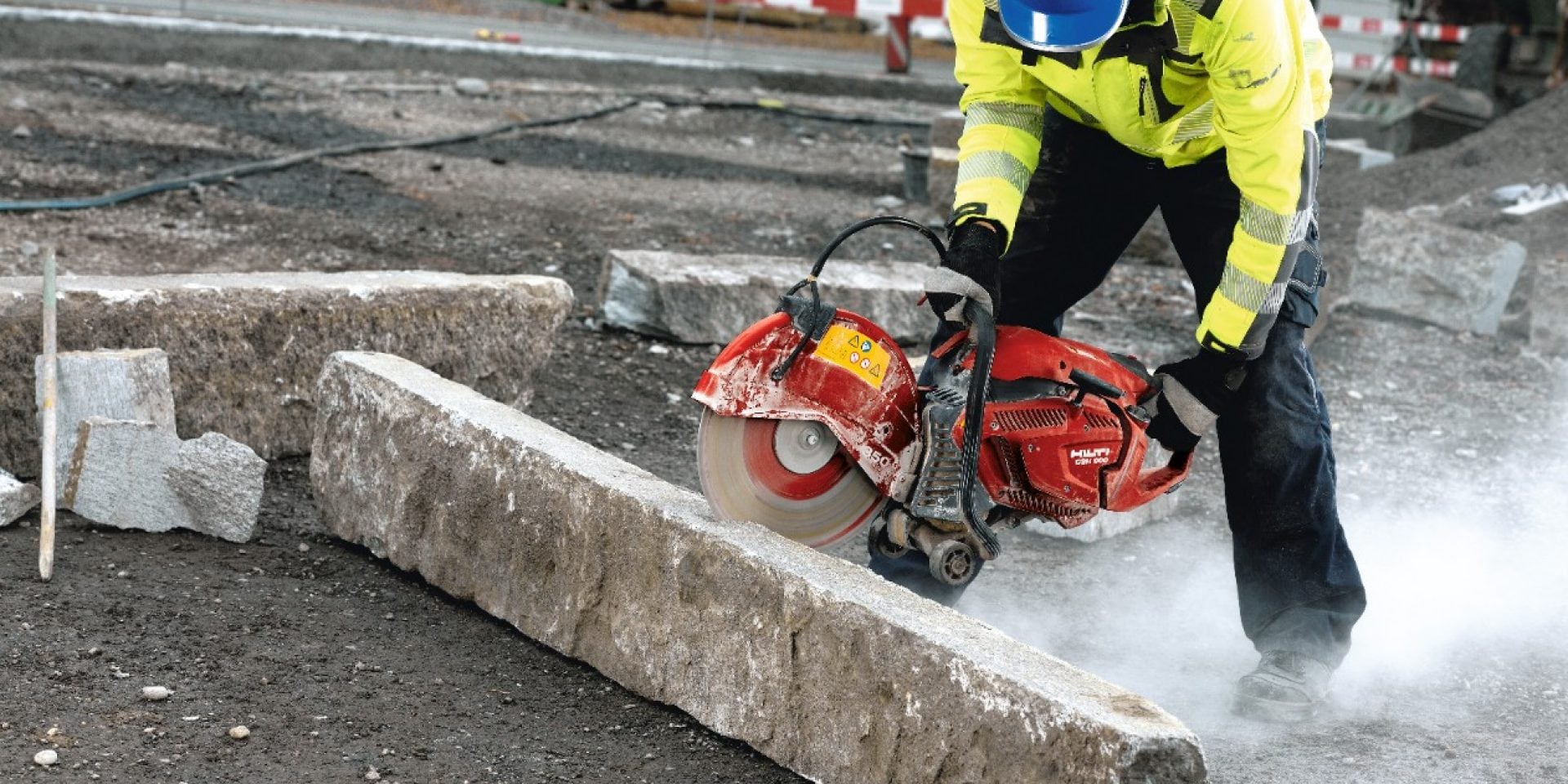- Home
- Company
- Health and Safety Community
- Being Aware of Dust
Why you should care about dust
Some HSE experts consider dust as the "new asbestos in the construction industry" because of its potentially hazardous consequences on health and safety

Depending on the processed base material, size of the dust particles, concentration in the air and the duration workers are exposed, dust can lead to severe health issues as well as loss of productivity and work comfort. In addition, dust does not just stay at the construction site. It can spread easily to other areas impacting people, nature and the environment.
Which workplace would you rather be working in?
Before we explore the consequences let’s examine some important background information about dust.
What is dust?
Dust consists of tiny solid particles, is highly dispersed, and easily circulated in the air. Dust particles can be very small and when smaller than 10 microns are classified as fine dust or particulate matter (PM). Dust bigger than 10 microns is classified coarse dust. Let’s put that into relation: the average human hair is about 60 microns thick.
Fine dust is invisible to the human eye and can only be seen if there is a lot of it in the air (clouds of dust). Because of its small particle size, it can stay in the air for up to 12 days. Sometimes, when we don’t see dust, we might still smell it e.g. if a room smells “like concrete” cement can be circulating in the air.
Fine dust particles are the most dangerous because they can be small enough to get into the respiratory system and potentially cause long-term damage. Over-exposure to respirable dust that contains silica can even cause cancer, silicosis and chronic obstructive pulmonary disease (COPD).
How does dust arise?
Dust is generated by abrasive treatment of materials like drilling, chiseling, sawing or grinding. But dust can also occur through circulation when it is blown up by wind or by movement of dusty material through transportation or while mixing powdery material, e.g. when preparing cement.
Depending on the material processed different types of dust occur. Here are two of the more dangerous types of dust relevant for the construction industry:
- Dust with crystalline structure: generated by abrasive treatment of material that contains silica e.g. sandstone, concrete, mortar or tile. It contains respirable crystalline silica (RCS)
- Dust with powder structure: occurs by abrasive treatment of wood and processed wood like medium-density fiberboard (MDF).
Dust is everywhere on the construction site
It’s a fact that dust is everywhere on a construction site. It occurs on nearly every point in the construction process during drilling, sawing, breaking, grinding and transportation. It is so ubiquitous that it’s often considered as normal and nothing to worry about. But that’s a false conclusion.
There is a lot of Dust
Some jobs create a huge amount of dust – for example slitting bricks and installing electrical cables can produce about 17 kg of dust an hour. Demolishing concrete ceilings for post-installation can produce about 6 kg of dust per hour.
Now add up all the work done on your construction site on a normal work day – that’s really a lot of dust your employees must deal with, right? So here comes the number one reason why you should care about dust.

Dust can have hazardous consequences to health and safety
A shockingly high number of people die each year of lung cancer because of over-exposure to respirable silica dust. Others suffer from dust-related diseases so badly that they can no longer work. So, dust can have severe consequences to your workforce if not tackled head-on. Several national and international organizations have realized the urgency of the issues and launched initiatives and campaigns to combat dust at the workplace (see info box at the bottom of the page).
As an employer, you are responsible for your workers’ health and safety on the construction site. It’s generally regulated by law but considering the consequences to individuals and their families it should be in your interest to protect your employees the best you can.
What are the consequences?
When the human body inhales dust, natural defense mechanisms kick in e.g. sneezing, coughing. But those human defense mechanisms are limited and for some kinds of dust ineffective. Special care must be taken when working with materials containing silica.
Silica is a natural material. About 27% of our earth crust is covered with it. It occurs in many materials common on constructions sites like sandstone, concrete, mortar, tile, brick and more.
When processing these materials, fine dust that contains respirable crystalline silica (RCS) occurs. Over-exposure to these RSC particles can be very dangerous because they reach deep into our lungs and settle in our lungs’ air sacks (alveoli). Over time scar tissue is produced and reduces the ability to breath-in oxygen. This incurable disease is called silicosis.
How breathing in silica dust can cause permanent damage to the lungs
Dust not only affects the lungs – it can also lead to other issues like eye and skin irritation or allergic reactions. Most of these diseases will take a longer time to develop but with high exposure to dangerous dust it can also develop quite fast and can raise drastic problems like:
- Reducing ability to work
- Reducing quality of life
- Permanently damaging health
Protecting your workforce from dust will significantly impact your employees’ health and quality of life.
Dust decreases productivity and increases maintenance costs
Most people would prefer to work in a clean environment where body, clothes and surroundings stay clean and no personal protective equipment must be worn.
Working in clouds of dust also increase the risk of injuries due to reduced visibility and can distract employees because of eye irritations, sneezing, coughing or nose blowing. But that’s not the only reason to take control of dust. You can significantly increase productivity and lower maintenance costs with appropriate measures against dust by:
- Reducing preparation time: no or minimal time sealing off the area required before work starts
- Reducing cleaning: depending on the application you can save up to 99% of cleaning time
- Reducing damage of fixtures and fittings: like carpets, furniture and other furnishings
- Increasing lifetime of tools: by up to 60% and of inserts by up to 20%
- Increasing application speed: up to 20% with cleaner and sharper tools
It’s a given that dust is a topic the construction industry must address. If you want to find out more read our article How to reduce dust and get insights how to tackle dust by using the STOP principle.




